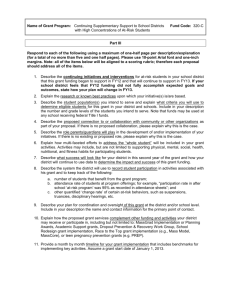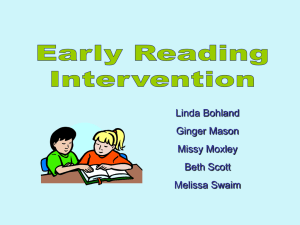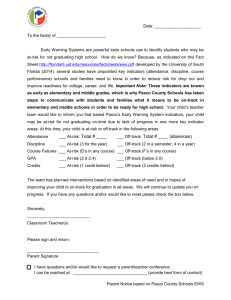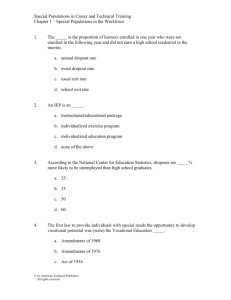At A Glance: Defining At-risk Populations Step 1 – Collect population
advertisement
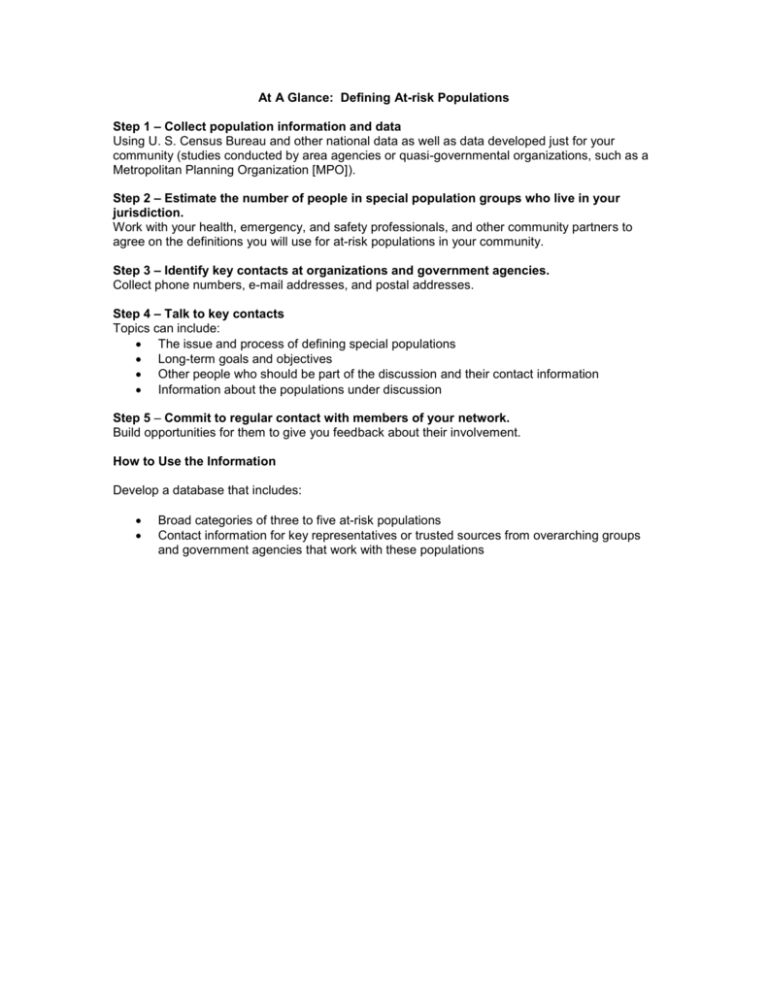
At A Glance: Defining At-risk Populations Step 1 – Collect population information and data Using U. S. Census Bureau and other national data as well as data developed just for your community (studies conducted by area agencies or quasi-governmental organizations, such as a Metropolitan Planning Organization [MPO]). Step 2 – Estimate the number of people in special population groups who live in your jurisdiction. Work with your health, emergency, and safety professionals, and other community partners to agree on the definitions you will use for at-risk populations in your community. Step 3 – Identify key contacts at organizations and government agencies. Collect phone numbers, e-mail addresses, and postal addresses. Step 4 – Talk to key contacts Topics can include: The issue and process of defining special populations Long-term goals and objectives Other people who should be part of the discussion and their contact information Information about the populations under discussion Step 5 – Commit to regular contact with members of your network. Build opportunities for them to give you feedback about their involvement. How to Use the Information Develop a database that includes: Broad categories of three to five at-risk populations Contact information for key representatives or trusted sources from overarching groups and government agencies that work with these populations At A Glance: Finding At-risk Populations Step 1 – Assess existing processes within your department or agency to find at-risk populations. Step 2 – Choose digital mapping or alternate methods. •If departmental resources are not available for mapping programs, consider working with a partner organization, such as a local Metropolitan Planning Organization (MPO) or regional council, department of transportation, fire departments, election offices, or others, many of which have access to such resources. If digital mapping is not available, consider using colored pins or dots placed on a map of your community to indicate the size and locations of defined at-risk population groups. Using Census and other data previously collected in the Define phase, map locations where there are significant numbers of people who are members of at-risk populations. Step 3 – Find and map gathering places for the at-risk populations you have identified. Create a map that shows the locations of community centers, missions, churches, or grocery stores that might be used by at-risk populations in an emergency). Step 4 – Identify and map trusted information sources. It is important to find contacts and service providers representing the at-risk population groups, and to know where they can be reached during an emergency. Step 5 — Facilitate discussions. Talk with leaders and representatives from community organizations that are connected with at-risk populations. Meeting face-to-face, in person, the first time will do a lot to build trust and build a solid foundation for an ongoing successful working partnership. Arrange roundtable meetings or conference calls. Discuss goals, objectives, roles, and common issues surrounding the challenges in accurately finding at-risk populations. Step 6 – Expand your COIN. Include service providers, businesses, faith-based organizations, community-based organizations and others who work with, represent, and belong to at-risk populations. Members of this network are your community collaborators and program partners. Maintain regular contact with the COIN members through a newsletter, conferences calls, or meetings. How to Use the Information Expand your database by storing additional names and contact information for community collaborators and program partners. Also include gathering places in the database. Update and maintain your database. Review the community organizations that helped you find atrisk populations and check to see if any of the contact information has changed. Develop policies and procedures to manage the information you gather and to maintain the confidentiality of the individual COIN members’ contact information. The success of your network is built upon trust. Define and address confidentiality issues when you begin your relationships. At a Glance: Reaching At-risk Populations Step 1 – Survey people from agencies and organizations. Learn about their successes and failures other departments have faced in reaching at-risk populations. Step 2 – Conduct focus groups. Focus groups or community roundtables with members of different at-risk population groups can identify their needs and barriers to communication. Step 3 – Analyze data. Information gathered from the surveys, focus groups, and your previous research efforts will help you find at-risk populations. Step 4 – Collaborate with community organizations. Work together with your partners to develop messages and materials that reach at-risk populations. Step 5 – Identify appropriate, trusted messengers to deliver the messages. How to Use the Information Update your database with information from your research on communication barriers for at-risk populations and preferred channels of communication. Enhance your communication plan to reach at-risk populations using a variety of methods, messages, and messengers. This plan can be part of organization’s existing crisis communication plan or a supplement. Exercise your network with drills and preparedness exercises. Look for gaps in message delivery. Revise your at-risk population outreach plans based upon the reports from your exercises. Exercise the effectiveness of your network at least annually. Expand your scope to include more at-risk population groups, enhance training of COIN members, or use the network for some day-to-day information dissemination activities Through the Lens of the Categories: Finding At-risk Populations: Economic Disadvantage Start with economic disadvantage to find people who are likely to need extra help in receiving or acting on health information in emergencies and in general. When you map the economically disadvantaged people living in poverty, you will also find many other populations from the categories of those who are at-risk because of limited language proficiency, disability, isolation (cultural, geographic or sensory), and age. For example, homeless people gather at shelters and food banks and in an emergency will turn to people at these places for information and guidance. Mapping this group will require identifying locations of shelters, soup kitchens, churches, and health clinics. Limited Language Proficiency People who share a common language and culture often live in the same communities. Community leaders may serve as excellent contacts for mapping language needs. In addition, public schools, community colleges, FBOs and multicultural community organizations often provide multilingual services, including classes in English as a Second Language (ESL). It can be very difficult to find information on the whereabouts and numbers of undocumented immigrants who can constitute a substantial population, and these resources can also help you map this group. Disability (physical, mental, cognitive, or sensory) People with disabilities who are not in an institutionalized setting don’t usually live in clusters, making them isolated and difficult to find and reach. As a group, they are very difficult to map; some communities have tried self-registry, designed to aid fire and emergency personnel in identifying mobility-challenged and energy-dependent persons, but getting people with physical disabilities to register has proved difficult. Confidentiality, particularly for persons with a chronic disease or other medical condition, also inhibits registries. However, many are members of affinity groups, both national and local organizations, where they create an informational – and sometimes social – community with other people who have similar challenges. Data you can use to find people with disabilities include information obtained from hospitals and other health service providers, rehabilitation organizations, veterans’ organizations, schools for the deaf and blind, and CBOs and FBOs. Isolation (cultural, geographic, or social) Isolation presents perhaps the biggest challenge to reach people with special needs. People in remote rural areas and in dense urban areas are often outside the “mainstream” of contemporary American life, by choice, or by simple fact of life. Both rural and urban populations in many locations can be mapped as part of the strategy that begins with economic disadvantage as a descriptor. Often simply finding the very poor in rural or urban areas is enough to assure that other aspects of special need will be reflected in the mapping. For example, if a 10-block area in an urban core is mapped because of deep poverty, and health and emergency personnel recognize that there will be special attention required in emergencies, people there who have other special needs – because of age, disability, limited language proficiency, etc. – are likely to be helped appropriately. ` To address both rural and urban isolation, collaborations may be the most important effort. Trusted information sources – persons who have credibility with others, regardless of title or official status – are critical to the work to find and reach people who are culturally, geographically or socially isolated. In rural areas, residents within a certain distance usually know each other. It is vital, however, for state, local, county, and tribal health and emergency professionals to know where these people are located in order to create strategies to reach them in day-to-day communication and especially in an emergency, particularly if electric power is lost. In the urban areas, people who are isolated by poverty, education, language skills, disability, and/or simply by choice, may not be enrolled in existing health department or social service programs. Police, utility workers, and others who know and work with people in these neighborhoods can help you find members of this special group. You can use information from CBOs, FBOs, volunteer organizations, neighborhood associations, public utilities, codes enforcement personnel, beat cops, and others to find people in your jurisdiction who are isolated. Age People who work with home-delivered meal programs as well as other elder care programs can be a good source of information to locate elderly persons. Schools can provide information to find children and family members in before- and after- school programs. You can also use data from group homes, senior centers, hospitals and daycare providers to find those who might be atrisk because of their age Through the Lens of the Categories: Reaching At-Risk Populations: Economic Disadvantage People who are economically disadvantaged can be reached through traditional communication channels, particularly television and radio. Messages should be simple, with easy to follow directions. The biggest barriers to receiving and acting on health information for this population are often the lack of resources to respond and a lack of awareness of possible threats to their health and well-being. Brochures, refrigerator magnets, picture books, and posters can be distributed through trusted individuals in health clinics, hospital emergency rooms, schools, human service agencies, and neighborhood community centers. In an emergency, you may need to use recognized community leaders to broadcast messages on television and radio; in the event of power failure, outreach may require door-to-door contact and/or reaching people at venues where they may have gathered. Limited Language Proficiency Within this broad population category, you may identify common characteristics such as: Cultural differences in healthcare and medical practices vary significantly from group to group and from the mainstream population. Language is a major barrier for many populations. Certain populations can be easy to reach through close-knit community relationships and elders/leaders, but may have significant differences in health-related cultural beliefs and may tend to require tailored messages because of cultural practices. Specific cultural and linguistic identifiers are important in defining at-risk populations. Hispanics often define themselves according to national origin. They speak different dialects and have different cultural practices. Individuals with limited English proficiency have difficulty understanding both written and verbal information in English. When possible, all written materials (brochures, posters, key directional signs, pocket guides) should be available in the languages that are common in your jurisdiction. When possible, keep all materials (even English materials) highly visual/pictorial, so that they will be useful to the various groups. Consider distributing language identification cards or posters (“I-speak” materials). These materials are prepared in advance and say “I speak (language). I need an interpreter” in various languages, to allow an individual to carry a card or point to text in their language to request an interpreter. Materials can be prepared in advance of a crisis, distributed through multicultural community centers, ESLR classes, places of worship, and ethnic markets. They can also be available at emergency shelters. The importance of the ethnic media in reaching people who speak little or no English is still underestimated by most health and emergency planners. Consider having important messages translated into various languages and recorded in advance, for use in the event of an emergency. Record the messages in English for the visually impaired. Disability (Physical, Mental, Cognitive, or Sensory) People with disabilities can be reached through traditional means, such as television/radio, newspapers, brochures, and phone trees. The following considerations may be helpful: People who are blind can be alerted through sirens and radio announcements. People who are deaf can be reached by using closed captioning and inscreen ASL interpretation on television, e-mail alerts, and text messaging. People with mobility limitations are usually self-sufficient, but they might need help to access transportation. People with cognitive disabilities can be reached through family members and trusted caregivers. Keep messages simple and repeat them often in an emergency. People who have mobility, sensory, or mental disabilities cannot always use standard resources available in an emergency. This includes people using oxygen, those dependent on electricity or medicines, or those with service animals, such as guide dogs. Your collaborators can help people with almost any form of disability by helping them create a buddy system in which a neighbor or co-worker will check on their welfare and assist them in an emergency. Isolation (Cultural, Geographic, or Social) You may find that people who live in rural areas often believe they are at low risk for terrorism. However, they are at-risk because they live near farms and raw food supplies, many power facilities, and U.S. military facilities. Other things to consider include: Sheriff’s, deputies, and postal workers can be good sources of information about rural residents and tourists/campers. But, many times, emergency crews and sheriff’s deputies cannot physically reach some areas during floods, blizzards, and other natural disasters. Rural residents also include migrant workers who may face additional barriers of language and culture. Faith-based organizations, inter-faith organizations and ministerial alliances in rural areas and urban centers are a common source of community information. Many remote rural areas have spotty or unreliable radio and television signals and little cell phone coverage. Factors that isolate people in dense urban areas – poverty, homelessness, low literacy, limited language proficiency, age – also come into play in overcoming barriers to receiving and responding to public health and emergency messages. As with other at-risk populations, messages should be brief, worded simply, and transmitted with pictures and other visual aids. People who work at shelters and food banks and police on patrol are most likely to know people who are homeless. Door-to-door outreach, calling trees, and recognized trusted neighborhood leaders can be effective in reaching isolated urban dwellers. Radio stations that appeal to specific urban audiences (e.g., young African Americans, Hispanic/Latino cultures) can be recruited as partners in outreach. Age Most people over the age of 65 and children ages 5 and older can be reached through television, radio, and printed materials. Some frail elderly, however, have hearing, sight, speech, physical, and cognitive impairments that can prevent them from understanding and responding to public health information and emergency directions. You may need to work through trusted caregivers, family members, and neighbors. A senior citizen phone tree, in which senior citizens volunteer to call other seniors in their community, can be an effective outreach tool for both ordinary and crisis communication. Very young children and school aged children who are in daycare or school can be reached through their teachers, daycare providers and family members with messages that promote awareness of public health issues and family emergency planning. Many families bring their children to focus groups, community roundtables, and other public involvement meetings. Simple coloring books can be created with pictures that illustrate good health habits, public health services, and emergency personnel who can be trusted.
